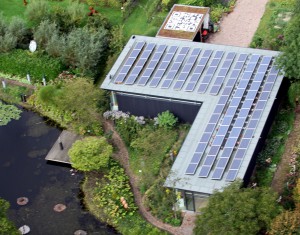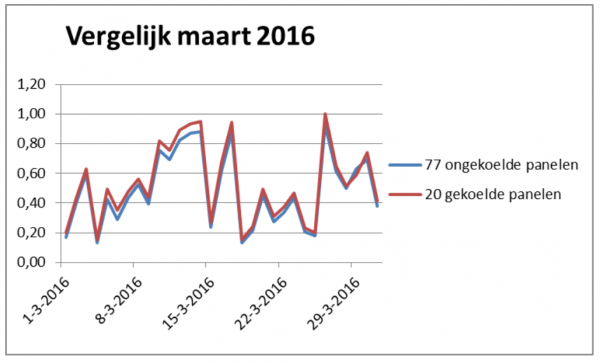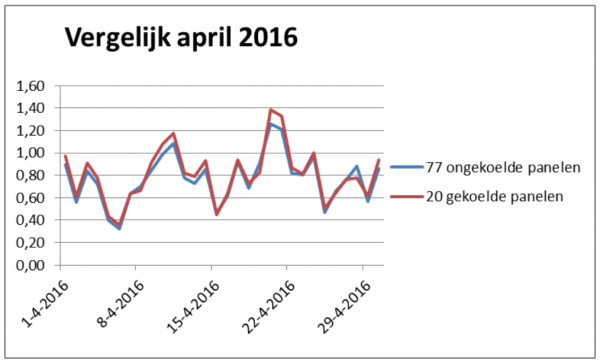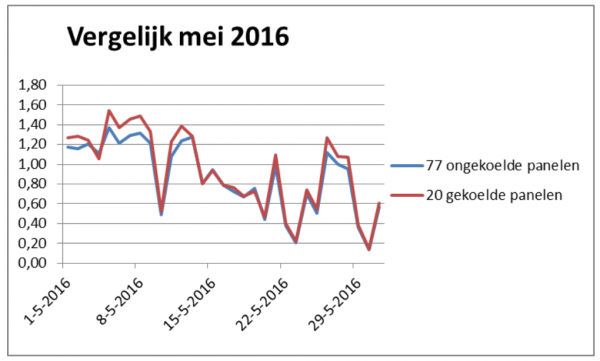 Analyse 20 gekoelde en 77 ongekoelde PV panelen bij Interart juli 2016
Analyse 20 gekoelde en 77 ongekoelde PV panelen bij Interart juli 2016
Introductie
Interart is de eerste duurzame galerie van Nederland en maakt al jaren lang gebruik van eigen opgewekte elektriciteit via zonnepanelen.
Deze duurzaamheid wordt door Interart als volgt omschreven:
“Maar liefst 97 zonnepanelen voorzien het volledige domein van Interart Beeldentuin & Galerie van elektriciteit. Mooier nog, we houden zelfs stroom over. Energie die we terug aan het net geven. De wanden van de galerie zijn herbruikbaar en gemaakt van gecertificeerd hout. Een warmte/koude-installatie verwarmt en koelt de galerie. En het regenwater wordt voor hergebruik gefilterd door middel van een helofytenfilter. Dit alles is samengebracht in een uitdagende en inspirerende ruimte waar kunst een passende uitstraling krijgt onder duurzame voorwaarden. Kortom, een galerie gecreëerd met het oog op morgen.”
De zonnepanelen zijn verdeeld onder 77 ongekoelde zonnepanelen en 20 gekoelde zonnepanelen.
Deze 20 gekoelde zonnepanelen zouden een beter elektrisch rendement moeten hebben t.o.v. de 77 ongekoelde zonnepanelen.
Dit rapport gaat in op de vraag of deze gekoelde zonnepanelen ook daadwerkelijk een hoger elektrisch rendement bieden.
1. BeNext & monitoring
Sinds de start van Interart is de galerie voorzien van BeNext Smart Home apparatuur om de modernste draadloze domotica toepassingen zoals smart bediening van verlichting, verwarming en beveiliging. Ook werd er op basis van CO2 metingen de natuurlijke ventilatie middels het smart aansturen van dakraam geregeld.
Via dezelfde smart home installatie zijn er uitbreidingen gedaan om energie-inzicht te krijgen in betreffende de zelf opgewekte energie, de van het net afgenomen energie en de aan het net teruggeveerde energie.
De 20 gekoelde zonnepanelen en de 77 ongekoelde zonnepanelen worden 24 uur per dag, 7 dagen per week gemeten. De waardes zijn realtime zichtbaar via de BeNext Smart Home app en worden voor rapportage opgeslagen in de BeNext Cloud.
Hierbij wordt de hoeveelheid opgewekte energie alsmede het mogelijke energie verbruik van de omvormer bij geen zon energie opgeslagen en geanalyseerd op het BeNext Cloud Platform.
2. Analyse
Voor de analyse zijn de laatste 3 maanden gebruikt om een vergelijk te maken tussen de beide PV systemen. Per maand is een opbrengst grafiek gegenereerd alsmede het vergelijk tussen beide PV systemen.
Dit vergelijk is gegenereerd door de dag opbrengsten te delen door het aantal panelen.
We hebben een aanname gedaan dat het rendement van de PV omvormers gelijk zijn waardoor de gemiddelde opbrengst teruggebracht mag worden naar de opbrengst per één zonnepaneel.
2.1. PV vergelijk maart 2016
Hieronder de opbrengst grafieken voor beide systemen.

- De totaal opgewekte energie voor de 77 ongekoelde panelen was: 1163 KWh
- De totaal opgewekte energie voor de 22 gekoelde panelen was: 327 KWh
Door beide systemen terug te brengen naar opbrengst per zonnepaneel, wordt de volgende informatie ontsloten:

Gemiddelde opbrengst per paneel over de maand maart:
- 77 ongekoelde panelen: 15,10 KWh
- 20 gekoelde panelen: 16,36 KWh
- Verschil in opbrengst: 8%
- De gemiddelde buitentemperatuur was 5,2 °C, dit is een gemiddelde op basis van KNMI data voor de plaats Volkel.
2.2 PV vergelijk april 2016
Hieronder de opbrengst grafieken voor de beide systemen.

- De totaal opgewekte energie voor de 77 ongekoelde panelen was: 1786 KWh
- De totaal opgewekte energie voor de 22 gekoelde panelen was: 486 KWh
Door beide systemen terug te brengen naar opbrengst per zonnepaneel, ontstaat de volgende informatie:

Gemiddelde opbrenst per paneel over de maand april:
- 77 ongekoelde panelen: 23,19 KWh
- 20 gekoelde panelen: 24,28 KWh
- Verschil in opbrengst: 5%
- De gemiddelde buitentemperatuur was 8,7 °C, dit is een gemiddelde op basis van KNMI data voor de plaats Volkel.
2.3 PV vergelijk mei 2016
Hieronder de opbrengst grafieken voor de beide systemen.

- De totaal opgewekte energie voor de 77 ongekoelde panelen was: 2092 KWh
- De totaal opgewekte energie voor de 22 gekoelde panelen was: 583 KWh
Door beide systemen terug te brengen naar opbrengst per zonnepaneel, ontstaat de volgende informatie:

Gemiddelde opbrenst per paneel:
- 77 ongekoelde panelen: 27,17 KWh
- 20 gekoelde panelen: 29,17 KWh
- Verschil in opbrengst: 7%
- De gemiddelde buitentemperatuur was 14,7 °C, dit is een gemiddelde op basis van KNMI data voor de plaats Volkel.
2.4 Overzicht 2016
De volgende tabel geeft de vergelijkings informatie van 2016 in één overzicht weer:

Deze meting geeft weer dat de 20 gekoelde panelen gemiddeld 7% hoger rendement hebben.
Tevens lijkt de buitentemperatuur geen meetbaar effect te hebben op het rendementsverschil tussen de gekoelde panelen en ongekoelde panelen.
N.B. uit de analyse van 2016 is gebleken dat er vanaf eind januari en over geheel februari geen energie is opgewekt door de 20 gekoelde panelen. De meting heeft wel plaatsgevonden, maar er is geen energie opgewekt. Dit kan een storing zijn geweest aan de omvormer.
2.5 Overzicht 2015
Wij hebben dezelfde meting uitgevoerd over 2015, startend vanaf juni.
De volgende tabel geeft de vergelijkings informatie weer over 2015. 
Deze meting geeft weer dat de 20 gekoelde panelen gemiddeld 5% hoger rendement hebben.
3. Conclusie analyse PV systeem Interart
- Met bovenstaande informatie werden de analyses toegelicht van de 77 ongeklede PV-panelen en de 20 gekoelde PV-panelen.
- Deze analyse dient hoofdzakelijk als doel om met metingen inzicht te geven in het mogelijke, en te verwachten, positieve rendementsverschil van gekoelde zonnepanelen.
- Zoals blijkt heeft een gekoeld PV systeem een rendementsverbetering tussen de 5% en 7%.
- Bij het inlezen in de voordelen van een PVT (PV + Thermisch) systeem, wordt gesproken over een mogelijk elektrisch rendementsvoordeel tussen de 5% en 10%.
- We mogen concluderen dat het rendementsvoordeel van de gekoelde panelen binnen de verwachting ligt.
- Daarnaast heeft een PVT het voordeel dat de gegenereerde warmte gebruikt kan worden in een CV systeem.
- Bij het schrijven van deze analyse is niet bekend waar de warmte uit PVT wordt gebruikt en of hier een zelfde rendementsverbetering zichtbaar is door voorverwarmt water te gebruiken.
- Het totale rendementsvoordeel van PVT kan namelijk 40% zijn, mits goed toegepast.
- Indien de PVT is gekoppeld aan de warmtepomp is hier een rendementsvoordeel te verwachten.
3.1 Additionele constateringen
Er zijn twee additionele constateringen te vermelden, namelijk:
- Tijdens de analyse op het elektrisch rendement van gekoelde zonnepanelen, is ook naar voren gekomen dat er een tijdelijke storing geweest moet zijn op de omvormer van de 20 gekoelde zonnepanelen.Het is mogelijk middels BeNext Smart Home een service dashboard af te nemen waarbij systeem onderdelen 24 uur per dag en 7 dagen in de week actief worden gemonitord en waardoor de verantwoordelijke bij een storing actief door het monitoringsysteem wordt geïnformeerd.
- De omvormer heeft ook energie verbruikt van het elektriciteitsnet.
Over 2015 gemeten komt dit neer op:
– 77 ongekoelde panelen 0,219 KWh
– 20 gekoelde panelen 0,024 KWhUit nadere analyse blijkt dat het energieverbruik van de omvormer met name ontstaat op het moment dat de omvormer aanschakelt bij voldoende zon.
Op deze manier kan worden gemeten wanneer het eventueel bewolkt is geweest, zelfs indien dit van korte duur was.
Uit de analyse blijkt ook dat tegen het einde van de dag met name energie opgenomen wordt, omdat dan de zonkracht af gaat nemen.Er kan een extra besparing worden gerealiseerd door proactief de omvormer uit te schakelen zodra het BeNext Smart Solutions Platform de indicatie heeft dat op de specifieke locatie geen voldoende zonkracht meer aanwezig is.
BeNext biedt tal van energiemanagement mogelijkheden en een complete smart home infrastructuur eenvoudig te bedienen voor bewoners.
BeNext Smart Home …wees de volgende!



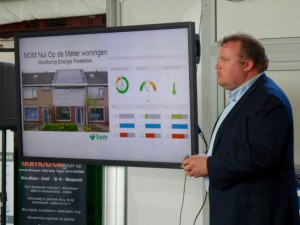
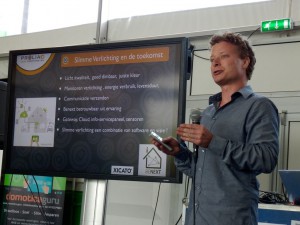
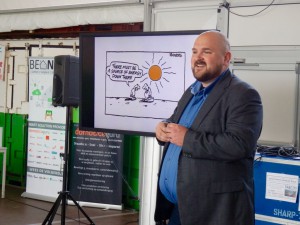
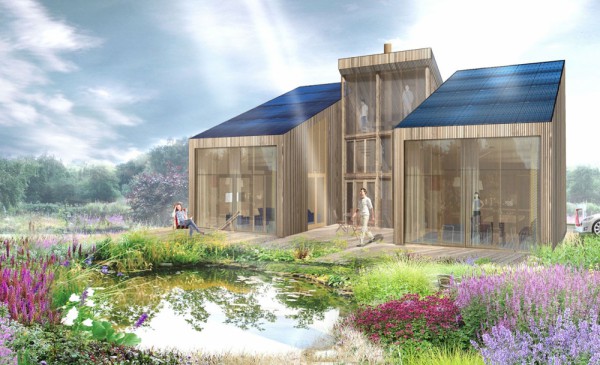


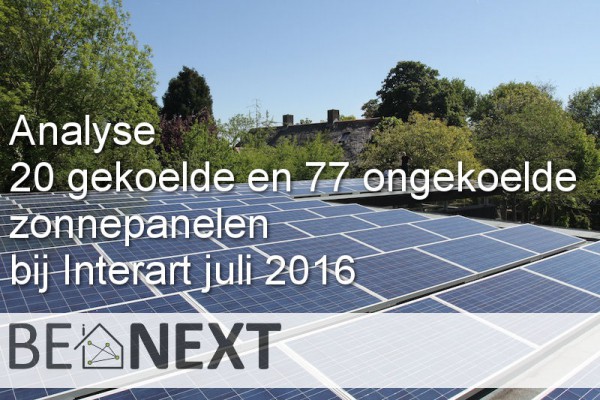 Analyse 20 gekoelde en 77 ongekoelde PV panelen bij Interart juli 2016
Analyse 20 gekoelde en 77 ongekoelde PV panelen bij Interart juli 2016